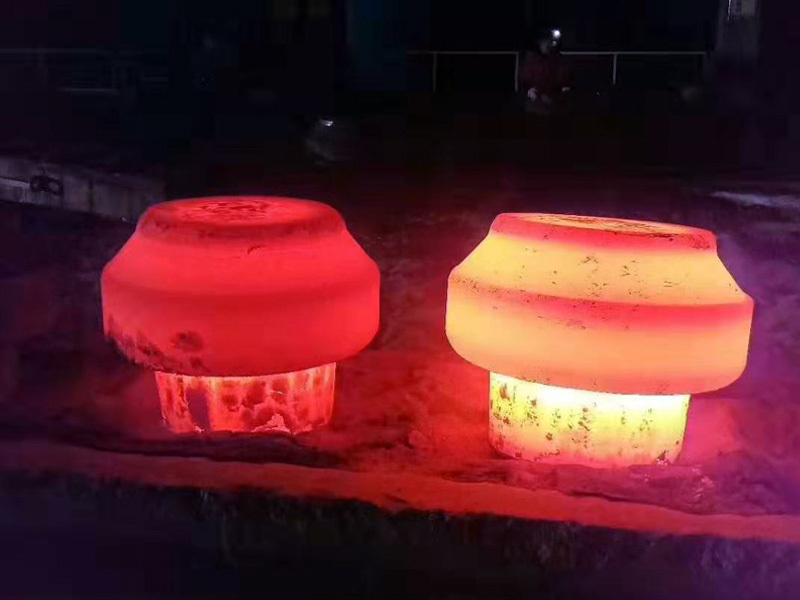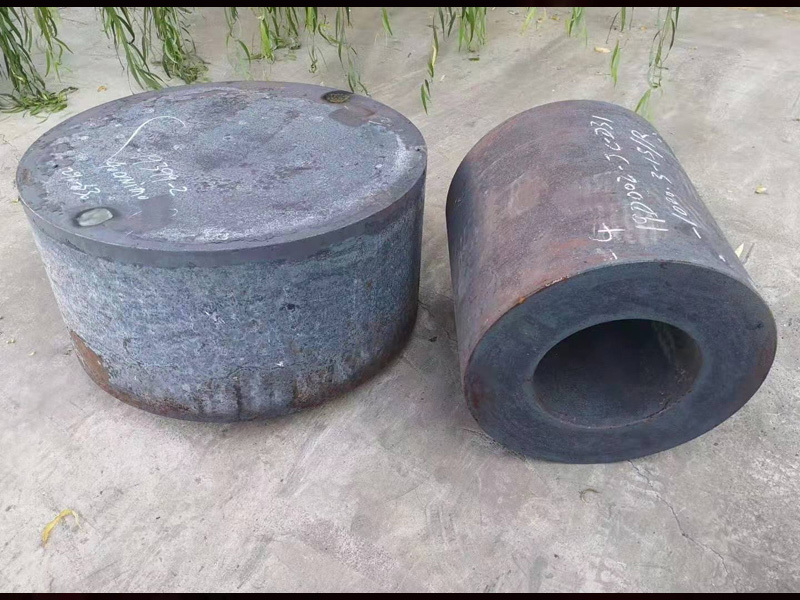Forging forming method of large piston rod forgings
Release time:
2024-03-29
The large piston rod forging is an important part of a certain type of ship with adjustable pitch propeller device, the material is 42CrMo steel, the middle is a large-flange, both ends are steps, the cross-sectional size changes are large. In the work by torsion, impact and other loads, high technical requirements. The manufacturing process of the piston rod is as follows: electric furnace smelting → vacuum refining → forging → heat treatment after forging → rough machining → ultrasonic testing (internal control) → quenching tempering → sampling and marking → testing → ultrasonic testing → * * * final processing → dimensional inspection → marking and delivery.

The large piston rod forging is an important part of a certain type of ship with adjustable pitch propeller device, the material is 42CrMo steel, the middle is a large-flange, both ends are steps, the cross-sectional size changes are large. In the work by torsion, impact and other loads, high technical requirements.
The manufacturing process of the piston rod is as follows: electric furnace smelting → vacuum refining → forging → heat treatment after forging → rough machining → ultrasonic testing (internal control) → quenching tempering → sampling and marking → testing → ultrasonic testing → * * * final processing → dimensional inspection → marking and delivery.
1 Smelting
Smelting using electric furnace smelting vacuum refining process route. The material is a conventional material, but due to high technical requirements, the chemical composition of smelting internal control should be adjusted within the scope of chemical composition acceptance, ingredients with high-quality scrap steel, material head, pig iron, it is strictly prohibited to mix into the iron, mixed with sediment, etc., and with a sufficient amount of pig iron, to ensure a certain amount of carbon. During pouring, ensure * * * * * * time, strictly control the injection temperature and injection speed, add sufficient heat preservation covering agent in time after pouring, ensure good shrinkage quality of cap mouth, and demould red delivery in strict accordance with the process requirements time to ensure the quality of steel ingot.
2 Forging
The product is a stepped shaft with a boss in the middle, but due to the large cross-sectional change and short length, if the traditional upsetting and drawing method is used, it is not only difficult to forge and form, but also the middle boss is not easy to forge through, and the internal quality of the product cannot be guaranteed. Therefore, during forging, the forming method of first upsetting, drawing and blanking, and then locally upsetting the middle boss of the leakage disc is selected, which is not only convenient for forging and forming, but also meets the requirements of non-destructive testing.
3. Heat treatment
After the piston rod is forged, rough machining shall be carried out and ultrasonic testing shall be carried out to determine whether there are defects affecting the heat treatment. The quenching and tempering heat treatment shall be carried out after the nondestructive testing is qualified. Before heat treatment, check whether all edges and corners of the product are obtuse and whether the sharp corners are smooth transition, so as to avoid cracking due to stress concentration at the sharp corners during quenching. As the piston rod requires tangential and longitudinal mechanical performance tests, and the end is sampled at 1/2 thickness, in order to obtain a better quenching effect, the inner hole of the piston rod is pre-processed before heat treatment to increase the contact area between the product and the quenching medium during quenching. When formulating the heat treatment parameters, considering that the product cross-section changes greatly, and the 42CrMo steel material direct water quenching may produce cracks, so take the first air cooling a little time, and then water quenching oil cooling method. During the quenching process, water circulation and oil circulation are started successively, and the product is fully moved to make the product cool evenly during the quenching process.
The results of chemical composition testing, mechanical performance testing, metallographic examination and ultrasonic testing in the manufacturing process of piston rod forgings all meet the technical requirements.
From the above development results, it can be seen that the actual chemical composition of the piston rod not only meets the acceptance requirements, but also effectively controls the impurity elements such as P and S and the elements such as C, Cr and Ni that affect the mechanical properties, which lays the foundation for the successful development of the project. The mechanical properties, metallographic examination and ultrasonic testing all meet the technical requirements, and the hardness is relatively uniform. However, because the sampling position at the middle boss is close to the surface, the result is slightly higher than that at the end. Forging using the upper and lower leakage disc local rough middle boss and heat treatment before the inner hole processing out of the manufacturing method is reasonable and feasible, can make the middle boss part forging ratio of 4.3, and can ensure that large cross-section products to obtain a higher grain size.
The piston rod boss is formed by upsetting and forging the upper and lower leakage plates, which solves the difficult problem of forging the middle boss, which is the key to the mechanical properties and grain size of the piston rod middle boss.
The inner hole of the piston rod is processed before heat treatment, and the air-water-oil cooling method is reasonable and feasible. It increases the contact area between the quenching medium and the product during heat treatment, and ensures that the mechanical properties are qualified after quenching.
More information








